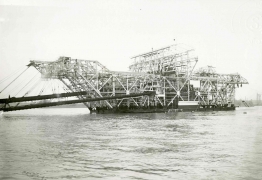Feedback
Kantoeng
General properties
Physical properties
About this page
Last Updated
About this equipment
The upturned hull
The bucket chain fell out and the wreck came to rest about half a mile from the Harbour entrance. On the following weekend holes were cut in her hull so that she sank thus alleviating any more danger to the harbour, and since there were still hopes of a salvage attempt it would be easy to patch the holes and raise the wreck with compressed air. Alas a survey later on by Lloyds declared her a total loss and the owners were compensated by the insurers for her full amount which was ?50,000. Later part of her pontoon was salvaged by the firm of Risdon Beazley, but the rest of the wreck was scattered over the years by storms, so that by the early 1960's all that was left showing above the water at low tide was a giant gear wheel.
Probably the largest in the world
Two massive diesel generators provided the power for the huge bucket chain which had 123 manganese steel buckets which were lowered through a large opening in the pontoon. Each bucket weighed 1.5 tons. After her launch the Kantoeng had two months for trials and fitting out before she left for her first assignment in Indoesia. She left Schiedam towed by two tugs on 4th March 1937 bound for Bamka in what was then the Dutch East Indies. Three days later she sprang a leak off Lands End and the Tug Master descided to turn back for Plymouth to get it fixed. The weather had been pretty bad since the voyage started and now got even worse. During Sunday night the wind got up to near gale force and the Kantoeng broke adrift near the Eddystone.
Tugs were sent out from Fowey and Torpoint but despite some men managing to get aboard the drifting vessel the tow could not be reconnected. As the leak increased, the Kantoeng took on so much water that she developed a severe list and the salvage men abandoned her. Shortly after the Kantoeng capsized and drifted upside down towards Fowey Harbour. By Monday night the vessel was about one and a half miles from the harbour entrance and there were fears that her wreck would block the harbour. The tugs and a Navy warship all tried to halt her onward path but to no avail. In the end it was her vast superstructure that saved the day by becoming stuck on the seabed on Tuesday afternoon.
The Kantoeng, at the time she was launched on 22nd of December 1936, was the largest bucket tin dredger in the world. She was built in Schiedam in Holland by A.F.Smulders for a Dutch mining company operating out of Indonesia. Because she was to be used in the swamps and jungle rivers of that country she bore little relationship to a conventional dredger, and was in fact little more than a huge floating pontoon 222 ft long, 75 ft wide and displacing over 3,500 tons. The machinery, bucket chain and superstructure was then just bolted on to the top. The Kantoeng had no means of propulsion, and had to be towed to all her jobs. However once at the site she could hold and shift her position by the use of four anchors each controlled by a powerfull electric winch.
http://resources3.kb.nl/010660000/pdf/DDD_010664235.pdf
Bij de directie van de Werf Gusto en bij de Internationale Sleepdienst Smit en Co., te Rotterdam, zijn berichten ingekomen, dat de tinbaggermolen „Kantoeng”, op weg naar Ned. – Indië, Zondagavond om 9 uur bij den vuurtoren Eddystone is omgeslagen.
Bron: Schiedamsche Courant, 08/03/1937; p. 1/6
Technical files and datasheets
No files available





